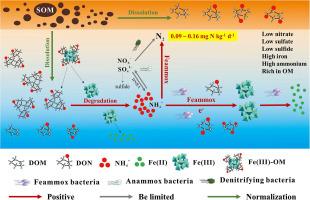当前位置:
X-MOL 学术
›
Water Res.
›
论文详情
Our official English website, www.x-mol.net, welcomes your
feedback! (Note: you will need to create a separate account there.)
Decoding the role of organic matter in groundwater Feammox processes: Insights from the Yangtze River paleochannel
Water Research ( IF 11.4 ) Pub Date : 2025-05-27 , DOI: 10.1016/j.watres.2025.123920
Chi Zhang, Yamin Deng, Yao Du, Hang Chen, Ruiyu Fan, Yanxin Wang
Water Research ( IF 11.4 ) Pub Date : 2025-05-27 , DOI: 10.1016/j.watres.2025.123920
Chi Zhang, Yamin Deng, Yao Du, Hang Chen, Ruiyu Fan, Yanxin Wang

|
Groundwater nitrogen (N) contamination is becoming increasingly severe worldwide. Anaerobic ammonia oxidation coupled with iron-reduction processes (Feammox) has great potential as an effective method for N removal in groundwater systems. However, previous studies on nitrogen removal by Feammox have generally focused on surface sediment soils, and the quantification of this process in groundwater remains inadequate. Moreover, the impact of native organic matter (OM) within the groundwater system on the Feammox process remains uncertain. The paleochannel of the middle reaches of the Yangtze River was selected as a representative study area for this research. The occurrence of Feammox and other N cycle (non-Feammox) processes in regional groundwater was identified and differentiated through the analysis of δ 15 N/δ 56 Fe isotopes and 16S rRNA functional gene quantification, along with hydrochemical characteristics. These findings indicate that the groundwater in the study area is characterized by anoxic conditions and slight acidity. The occurrence of Feammox is substantiated by an increase in δ 15 NNH4 , which coincides with the concurrent increase of Fe(II) concentrations and δ 56 Fe values in the groundwater, alongside the predominance of Acidimicrobiaceae bacterium A6 . 15 N isotope-labeled incubation experiments demonstrated that the potential rate of N removal via the Feammox process in the groundwater system ranged from 0.09 to 0.16 mg N kg-1 d-1 . Correlation results suggested that the functional microorganisms facilitating the Feammox process are closely linked to environmental factors associated with organic matter activity. Terrestrial humic substances present in groundwater, characterized by a high degree of unsaturation, aromaticity, humification, elevated biological activity, and nitrogen-rich composition, may act as pivotal drivers of the Feammox process.
中文翻译:

解读有机物在地下水 Feammox 过程中的作用——来自长江古河道的见解
地下水氮 (N) 污染在世界范围内日益严重。厌氧氨氧化与铁还原过程 (Feammox) 相结合,作为地下水系统中脱氮的有效方法具有巨大潜力。然而,以前关于 Feammox 脱氮的研究通常集中在表层沉积物土壤上,地下水中这一过程的量化仍然不充分。此外,地下水系统内的天然有机物 (OM) 对 Feammox 过程的影响仍不确定。选择长江中游古河道作为本研究的代表性研究区。通过分析 δ15N/δ56Fe 同位素和 16S rRNA 功能基因定量以及水化学特性,鉴定和区分区域地下水中 Feammox 和其他 N 循环 (non-Feammox) 过程的发生。这些发现表明,研究区域的地下水具有缺氧条件和轻微酸性的特点。Feammox 的出现通过 δ15NNH4 的增加得到证实,这与地下水中 Fe(II) 浓度和 δ56Fe 值同时增加,以及酸性微生物科细菌 A6 的优势相吻合。15N 同位素标记的孵育实验表明,地下水系统中通过 Feammox 过程去除 N 的潜在速率范围为 0.09 至 0.16 mg N kg-1d-1。相关性结果表明,促进 Feammox 过程的功能性微生物与与有机物活性相关的环境因素密切相关。 地下水中存在的陆生腐殖质物质具有高度不饱和度、芳香性、腐殖化、生物活性高和富含氮的成分,可能是 Feammox 过程的关键驱动因素。
更新日期:2025-05-27
中文翻译:

解读有机物在地下水 Feammox 过程中的作用——来自长江古河道的见解
地下水氮 (N) 污染在世界范围内日益严重。厌氧氨氧化与铁还原过程 (Feammox) 相结合,作为地下水系统中脱氮的有效方法具有巨大潜力。然而,以前关于 Feammox 脱氮的研究通常集中在表层沉积物土壤上,地下水中这一过程的量化仍然不充分。此外,地下水系统内的天然有机物 (OM) 对 Feammox 过程的影响仍不确定。选择长江中游古河道作为本研究的代表性研究区。通过分析 δ15N/δ56Fe 同位素和 16S rRNA 功能基因定量以及水化学特性,鉴定和区分区域地下水中 Feammox 和其他 N 循环 (non-Feammox) 过程的发生。这些发现表明,研究区域的地下水具有缺氧条件和轻微酸性的特点。Feammox 的出现通过 δ15NNH4 的增加得到证实,这与地下水中 Fe(II) 浓度和 δ56Fe 值同时增加,以及酸性微生物科细菌 A6 的优势相吻合。15N 同位素标记的孵育实验表明,地下水系统中通过 Feammox 过程去除 N 的潜在速率范围为 0.09 至 0.16 mg N kg-1d-1。相关性结果表明,促进 Feammox 过程的功能性微生物与与有机物活性相关的环境因素密切相关。 地下水中存在的陆生腐殖质物质具有高度不饱和度、芳香性、腐殖化、生物活性高和富含氮的成分,可能是 Feammox 过程的关键驱动因素。


















































 京公网安备 11010802027423号
京公网安备 11010802027423号